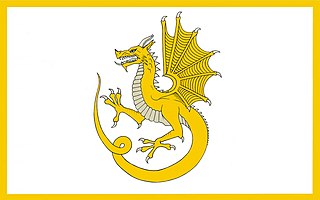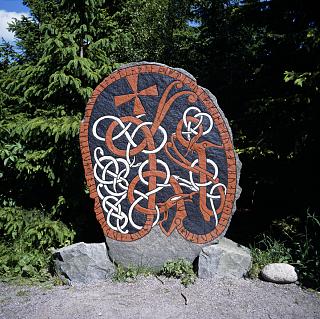
A dragon is a large, serpentine, legendary creature that appears in the folklore of many cultures worldwide. Beliefs about dragons vary considerably through regions, but dragons in western cultures since the High Middle Ages have often been depicted as winged, horned, four-legged, and capable of breathing fire. Dragons in eastern cultures are usually depicted as wingless, four-legged, serpentine creatures with above-average intelligence.

The Loch Ness Monster, or Nessie, is a creature in Scottish folklore that is said to inhabit Loch Ness in the Scottish Highlands. It is often described as large, long-necked, and with one or more humps protruding from the water. Popular interest and belief in the creature has varied since it was brought to worldwide attention in 1933. Evidence of its existence is anecdotal, with a number of disputed photographs and sonar readings.

The European dragon is a legendary creature in folklore and mythology among the overlapping cultures of Europe.

An ogre is a legendary monster usually depicted as a large, hideous, man-like being that eats ordinary human beings, especially infants and children. Ogres frequently feature in mythology, folklore, and fiction throughout the world. They appear in many classic works of literature, and are most often associated in fairy tales and legend with a taste for infants.

A wyvern is a legendary winged dragon that is bipedal and usually depicted with a tail ending in a diamond- or arrow-shaped tip.

Sea monsters are beings from folklore believed to dwell in the sea and often imagined to be of immense size. Marine monsters can take many forms, including sea dragons, sea serpents, or tentacled beasts. They can be slimy and scaly and are often pictured threatening ships or spouting jets of water. The definition of a "monster" is subjective; further, some sea monsters may have been based on scientifically accepted creatures, such as whales and types of giant and colossal squid.
A lake monster is a lake-dwelling entity in folklore. The most famous example is the Loch Ness Monster. Lake monsters' depictions are often similar to sea monsters.

The lindworm or lindwurm was a popular motif found on runestones in 11th-century Sweden. Portrayals vary across countries and the stories in which they appear, the creature generally appearing as wingless with a serpentine body, dragon's head, scaled skin and two clawed forelimbs. Depictions imply lindworms do not walk on their two limbs like a wyvern, but move like a mole lizard: they slither like a snake and use their arms for traction.
Karl Shuker is a British zoologist, cryptozoologist and author. He lives in the Midlands, England, where he works as a zoological consultant and writer. A columnist in Fortean Times and contributor to various magazines, Shuker is also the editor-in-chief of the Journal of Cryptozoology, which began in November 2012.

An Amphiptere is a type of winged serpent found in European heraldry.
The Brosno dragon, also known as Brosnya, is a lake monster which in Russian folklore is said to inhabit Lake Brosno, near Andreapol in western Russia. It is described as resembling a dragon and is the subject of a number of regional legends, some which are said to date back to the 13th century.

Japanese dragons are diverse legendary creatures in Japanese mythology and folklore. Japanese dragon myths amalgamate native legends with imported stories about dragons from China, Korea and the Indian subcontinent. The style of the dragon was heavily influenced by the Chinese dragon. Like these other East Asian dragons, most Japanese ones are water deities associated with rainfall and bodies of water, and are typically depicted as large, wingless, serpentine creatures with clawed feet. The modern Japanese language has numerous "dragon" words, including indigenous Tatsu from Old Japanese ta-tu, Sino-Japanese ryū or ryō竜 from Chinese lóng龍, nāga ナーガ from Sanskrit nāga, and doragon ドラゴン from English "dragon".

In American folklore, Champ or Champy is the name of a lake monster said to live in Lake Champlain, a 125-mile (201 km)-long body of fresh water shared by New York and Vermont, with a portion extending into Quebec, Canada. The legend of the monster is considered a draw for tourism in the Burlington, Vermont and Plattsburgh, New York areas.

The legend of the Loch Ness Monster is well known throughout Scotland and the rest of the world and has entered into popular culture.

Roy P. Mackal was a University of Chicago biologist best known to the general public for his interest in cryptozoology.

A monster movie, monster film, creature feature or giant monster film is a film that focuses on one or more characters struggling to survive attacks by one or more antagonistic monsters, often abnormally large ones. The film may also fall under the horror, comedy, fantasy, or science fiction genres. Monster movies originated with adaptations of horror folklore and literature. Typically, movie monsters differ from more traditional antagonists in that many exist due to circumstances beyond their control; their actions are not entirely based on choice, potentially making them objects of sympathy to film viewers.

The Water Horse: Legend of the Deep is a 2007 fantasy drama film directed by Jay Russell and written by Robert Nelson Jacobs, based on Dick King-Smith's children's novel The Water Horse. It stars Alex Etel as a young boy who discovers a mysterious egg and cares for what hatches out of it: a "water horse" which later becomes the fabled Loch Ness Monster. The film also stars Emily Watson, Ben Chaplin and David Morrissey.













